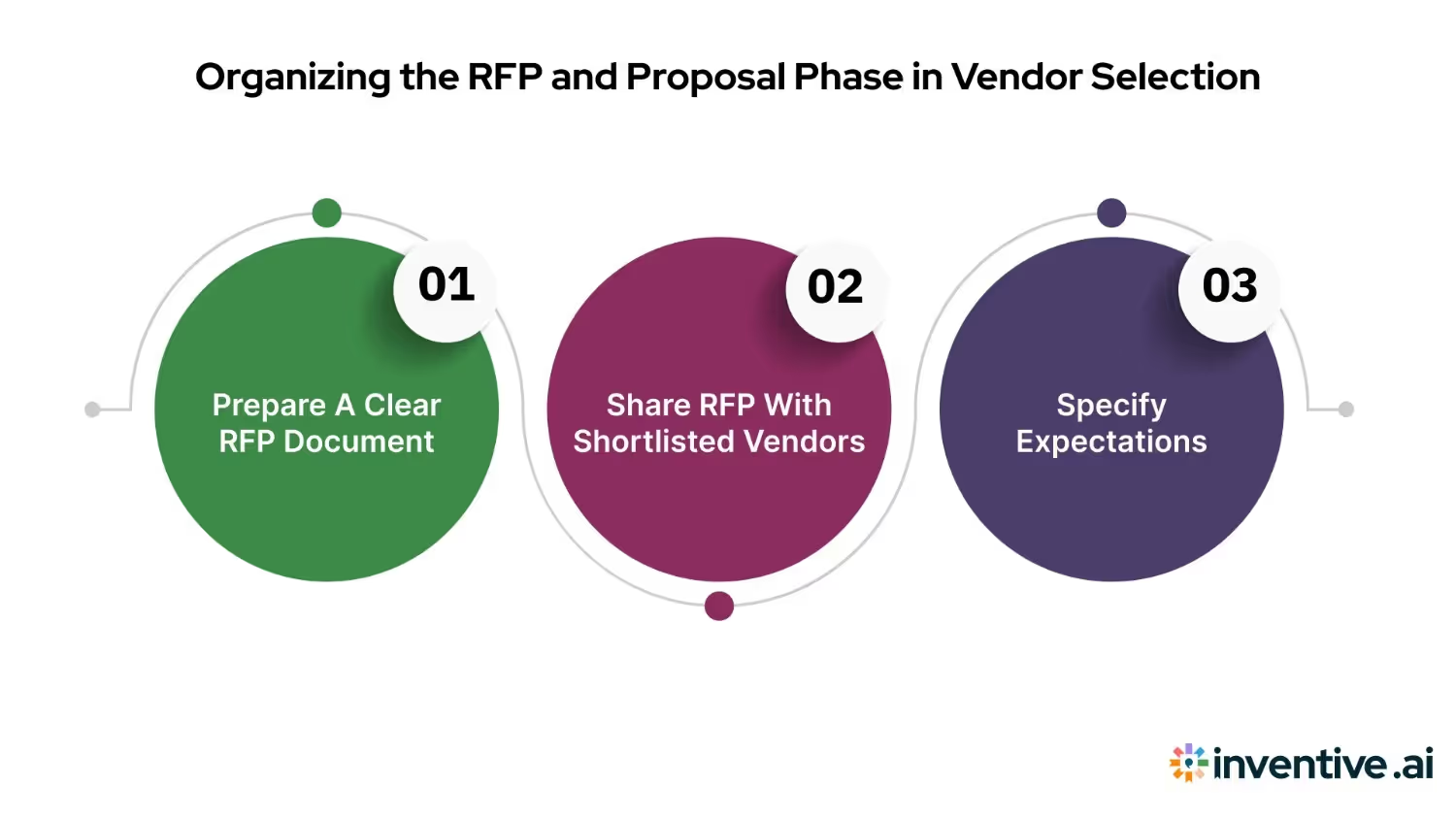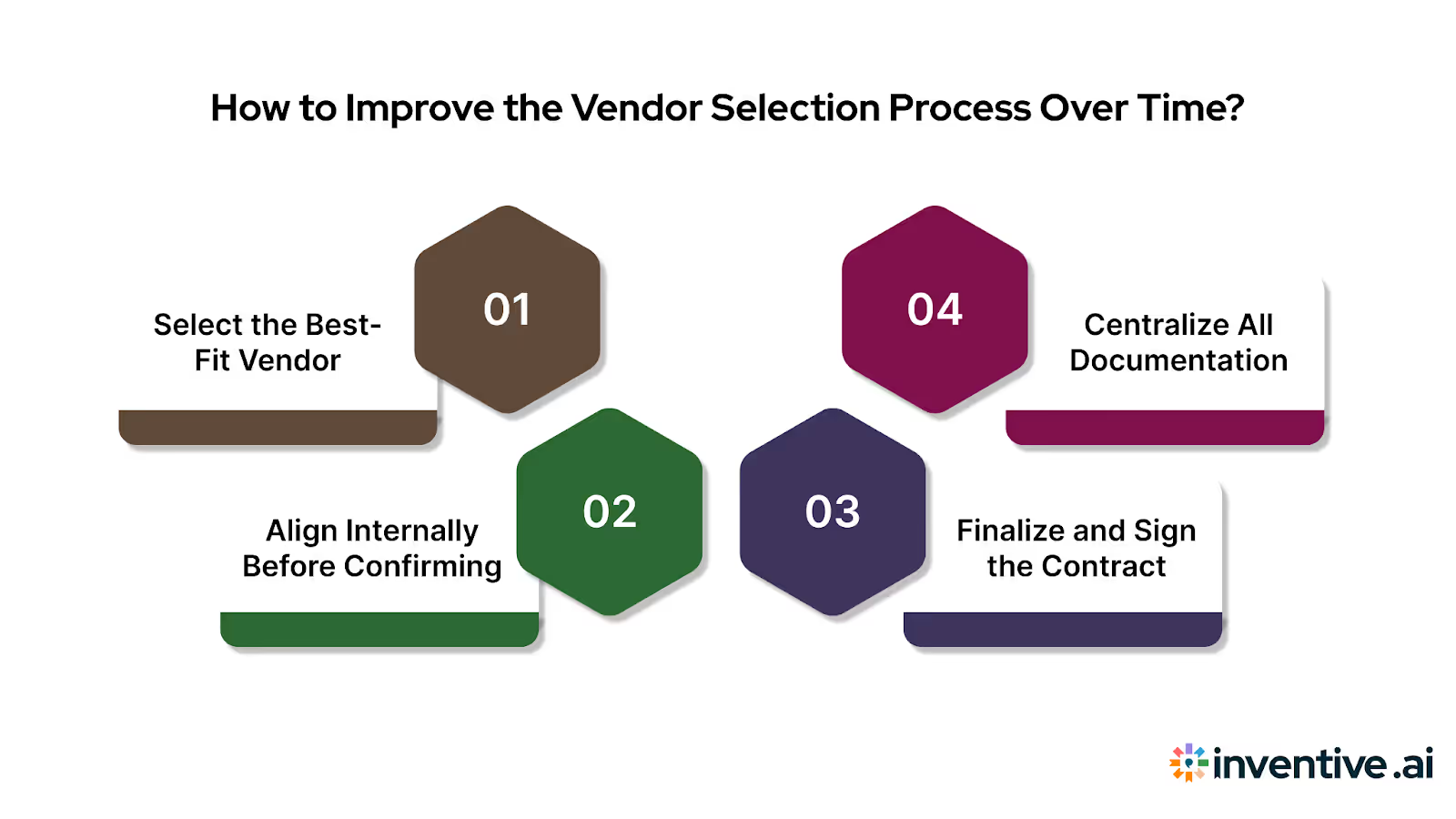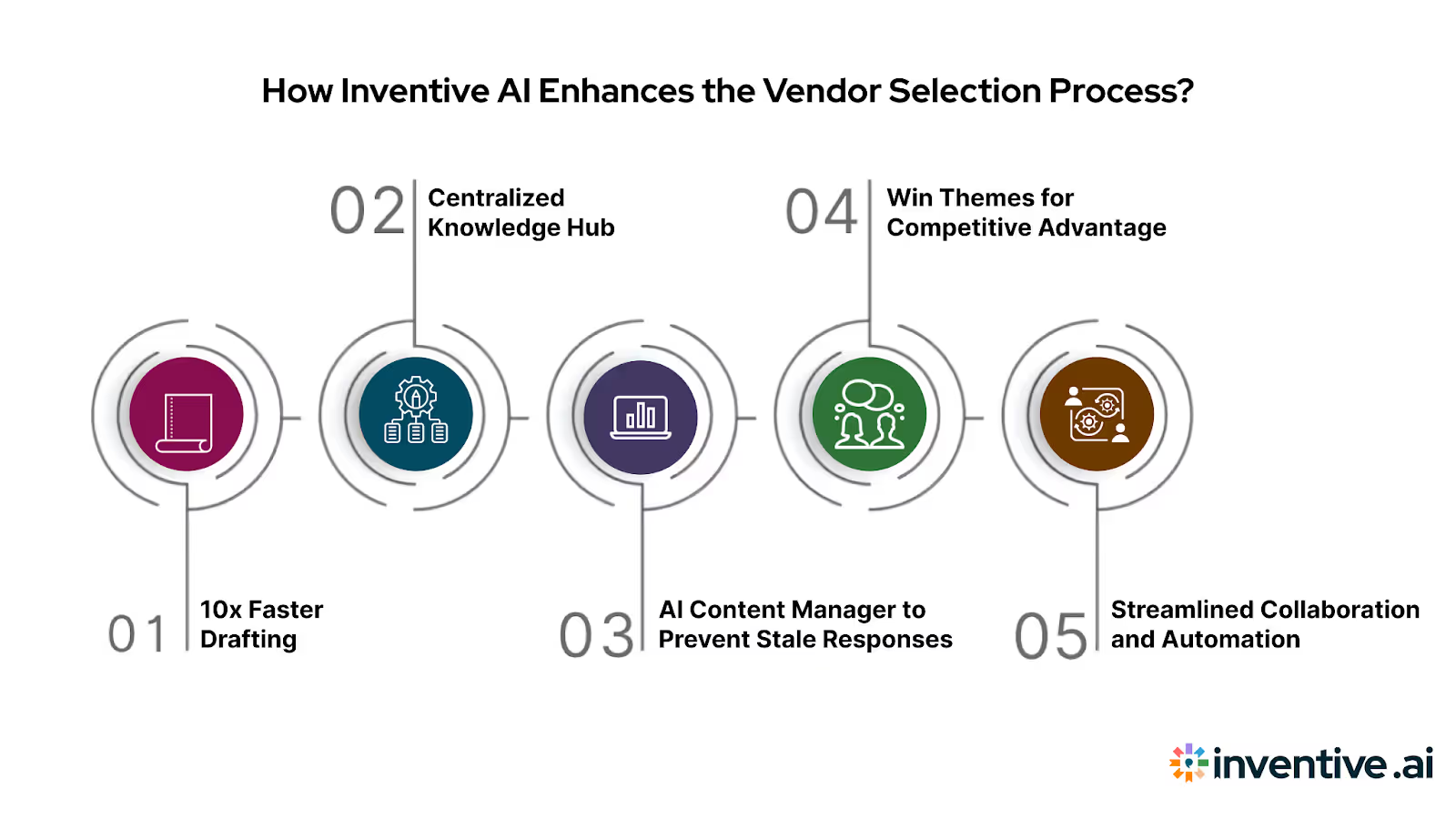Complete Guide to Vendor Selection Procedure Steps
Master the vendor selection process with tips on RFPs, evaluating proposals, and conducting vendor interviews. Start optimizing your strategy today!

Have you ever approved a vendor only to watch the project miss deadlines, overshoot the budget, or fall short on quality?
You’re not alone. 21.1% of project team members report dissatisfaction with their ERP solutions, and one of the root causes is an unstructured or rushed vendor selection process. For decision-makers like Chief Revenue Officers, VPs of Sales, and Proposal Managers, the consequences of choosing the wrong vendor can ripple through delivery timelines, revenue goals, and client relationships.
The vendor selection process is a structured approach used to evaluate, compare, and choose external suppliers or service providers based on predefined business needs and performance criteria.
When done right, it helps organizations ensure consistent quality, reduce operational and compliance risks, and stay within budget constraints; all while building reliable, long-term vendor partnerships.
This guide breaks down each stage of the vendor selection process, offering practical, step-by-step advice to help you make informed decisions, avoid common pitfalls, and improve the success rate of every project you lead.
Quick Summary
- A clearly defined vendor selection process reduces risk by aligning internal teams on requirements, budget, and evaluation criteria before engaging vendors.
- Using a centralized knowledge hub and AI-powered tools streamlines vendor research, proposal drafting, and content management, boosting efficiency and accuracy.
- Objective evaluation combines quantitative scoring with qualitative factors like communication and flexibility to shortlist vendors that fit both technically and culturally.
- Documenting every stage from requirements to final contracts builds a knowledge base that improves future vendor decisions and accountability.
- Continuous process improvement through regular reviews and adapting criteria keeps vendor selection aligned with evolving business goals and market conditions.
What Is the Vendor Selection Process? Key Objectives
The vendor selection process is a structured approach used to identify, assess, and contract the most suitable external partner or service provider for a specific business need. This process is critical for teams that rely on outside vendors to deliver key components, services, or technology, especially during high-stakes RFPs.
With over 80% of small and medium enterprises relying on ERP systems to manage vendor workflows, the stakes have never been higher.
For CROs and revenue teams, a disciplined vendor selection process directly supports better outcomes: more competitive offerings, smoother project execution, and stronger client delivery. For Proposal Managers and sales teams, it ensures the chosen vendor can meet proposal promises without risking delays or budget overrun.
Key Objectives of the Vendor Selection Process:
- Reduce risk by avoiding underqualified or unstable vendors
- Ensure technical, operational, and pricing alignment
- Meet deadlines and maintain consistency in client delivery
- Protect profit margins by avoiding unexpected vendor-related costs
Strategic Importance in Business Operations
Selecting the right vendor isn’t just a procurement task. It shapes long-term business performance. Every vendor choice impacts your cost structure, service quality, scalability, and ability to deliver on client expectations.
A weak vendor can slow down implementation, introduce compliance issues, or hurt your win rate by missing RFP requirements. For leadership and proposal teams, this can directly affect revenue.
Consequences of Poor Vendor Choices:
Direct vs. Indirect Procurement: Key Differences
Understanding procurement types helps teams refine how vendors are selected and evaluated.
- Direct procurement involves acquiring goods or services directly tied to your product or service delivery.
- Indirect procurement involves support functions like IT tools, marketing services, or office supplies.
Examples:
Why it matters:
- Direct procurement requires strict performance tracking, technical validation, and SLA definitions.
- Indirect procurement often allows more flexibility but still needs budget and compliance checks.
When and Why Organizations Use a Vendor Selection Process
A formal vendor selection process becomes necessary when internal teams need external support for critical deliverables. This is especially true during RFP cycles, scaling operations, or digital transformation initiatives.
Common Scenarios:
- Launching a new client project that requires third-party integration or support
- Replacing an underperforming vendor due to recurring delays or quality issues
- Expanding into new markets or regions that require localized services
- Tight timelines that demand specialized tools or services not available in-house
Internal Decision Triggers:
- Proposal teams need confirmed capabilities from vendors to commit in RFPs
- Sales teams require reliable partners to deliver promised outcomes
- CROs need clear cost structures and reduced risk for revenue planning
Pre-Selection Stage in the Vendor Selection Process

Before engaging with external vendors, internal alignment is essential. The pre-selection stage ensures that everyone involved understands the project’s goals, constraints, and evaluation standards.
1. Define Business or Project Requirements
Every vendor selection starts with a clear statement of need. This helps prevent miscommunication later in the process and ensures vendors respond with relevant, aligned solutions.
How to define your need statement:
- Goals: What is the expected business or project outcome?
- Scope: What’s included and what’s not? Outline deliverables and success criteria.
- Constraints: Identify dependencies, integrations, or compliance requirements.
Involve functional teams early, especially:
- Technical stakeholders (IT, solutions architects)
- Operational leads or SMEs from affected departments
- Legal or compliance teams, if regulatory alignment is needed
This ensures all proposal and implementation expectations are informed by actual internal needs.
2. Form the Internal Selection Committee
Vendor selection should never rely on a single point of view. A cross-functional committee ensures balanced decision-making that reflects business, technical, and financial priorities.
Typical selection committee roles:
The key is role-based evaluation. Each member focuses on specific decision factors, minimizing personal bias.
3. Set Budget, Timelines, and Scope
Unclear budgets and unrealistic deadlines are common reasons vendor proposals miss the mark. This leads to longer negotiation cycles and potential project delays.
Why this step matters:
- Budget: Vendors can disqualify themselves if pricing is far off target.
- Timeline: Set expectations for proposal delivery, implementation, and go-live.
- Scope clarity: Prevents feature creep and helps vendors quote total cost of ownership accurately.
Example: What to define up front
4. Establish Clear Evaluation Criteria
Without predefined criteria, decisions tend to rely on subjective opinions or default to cost alone. Structured evaluation improves transparency and speeds up final selection.
Common criteria to include:
- Cost and payment terms
- Product or service quality
- Compliance and certifications
- Relevant experience and references
- Delivery timelines
- Support and SLAs
Use weighted scoring models to prioritize what matters most to your project. For example:
Tools like Excel, Airtable, or AI RFP agents such as Inventive AI can streamline this step and ensure visibility and collaboration across all stakeholders.
Also Read: RFI vs. RFP: Understanding the Key Differences and How AI Optimizes Both
Once internal needs are clear, the next step is to identify and research potential vendors that meet those requirements.
Identifying and Researching Potential Vendors
Once internal requirements are defined, the next step is identifying which vendors can actually meet those needs. A structured approach to vendor research avoids wasting time on low-fit providers and ensures your shortlist is based on verified performance, not marketing claims. Thorough research at this stage empowers proposal teams to tailor responses with precision, improving both win rates and post-sale execution.
How to Find Vendors (Directories, Referrals, Online Platforms)
The first step is sourcing a diverse and reliable set of vendor options. Relying on just one source limits perspective and increases risk.
Recommended sources to identify vendors:
Best practice: Evaluate at least 3 to 5 vendors from a mix of these sources to build a strong comparison set.
Assess Vendor Capabilities and Reputation
Initial research should go beyond surface-level claims. You need to validate whether a vendor can meet your specific requirements and do so consistently.
Key factors to assess:
- Years in business: Longevity suggests operational stability.
- Client portfolio: Look for similar-size clients or industries.
- Customer reviews: Prioritize detailed feedback over star ratings.
- Certifications: ISO, SOC 2, or industry-specific compliance.
- References or case studies: Ask for success stories or relevant past work.
What to request:
- 2–3 case studies aligned with your project type
- Sample deliverables or demos, if applicable
- Contact info for 1–2 client references
This level of validation helps Proposal and Sales teams confidently commit to deliverables during RFP responses.
Use of Technology and AI Tools to Streamline Vendor Research
Manual vendor vetting is slow and often inconsistent. AI-driven tools can reduce time spent on research while improving decision quality.
Platforms that support vendor discovery and evaluation:
How AI Improves Vendor Research
Vendor research is often the most time-intensive step in the selection process. Traditionally, it requires comparing dozens of proposals, reading through endless documentation, and reaching out for references—all while managing deadlines. AI changes this dynamic by introducing automation, pattern recognition, and predictive insights.
1. Automated Vendor Capability Comparison
Instead of manually cross-checking vendor offerings, AI tools map each vendor’s capabilities against your project requirements. They can score vendors on predefined criteria, such as technical expertise, compliance certifications, or geographic coverage; making it easier to see who meets must-haves versus nice-to-haves.
Example: An AI platform can automatically generate a comparison chart that shows which vendors meet ISO security standards or integrate with your existing ERP system.
2. Intelligent Red Flag Detection
AI goes beyond marketing brochures by analyzing real-world data from customer reviews, ticket resolution times, and even social listening feeds. It identifies warning signs; like recurring issues with uptime, hidden fees, or poor customer support—that could jeopardize your project.
Benefit: Instead of discovering risks during implementation, you can eliminate problematic vendors early in the research stage.
3. Accelerated Shortlisting
AI filters a large vendor pool based on practical constraints like budget, industry fit, and scope of work. This ensures that only vendors who are realistically aligned with your requirements make it to the evaluation phase.
Impact: Teams spend less time reviewing irrelevant options and more time comparing qualified contenders, cutting the shortlisting phase from weeks to days.
4. Predictive Insights for Smarter Decisions
Some advanced AI platforms provide predictive scoring by analyzing historical win/loss data and customer satisfaction trends. This helps you estimate not just who can deliver, but who is most likely to succeed with your organization.
Why This Matters?
AI-enhanced vendor research not only reduces manual effort but also improves decision quality. It shifts the process from being reactive and time-heavy to data-driven and strategic, enabling procurement and project teams to select vendors with greater confidence.
In short, AI turns vendor research into a streamlined, insight-rich step that saves time, reduces risk, and improves alignment with business goals.
After identifying vendors, structuring a clear and detailed RFP ensures you gather precise and comparable proposals.
Structuring the RFP and Proposal Phase for Vendor Selection
Once potential vendors are identified, the next step is to issue a clear, targeted Request for Proposal (RFP). A strong RFP reduces misunderstandings, filters out poor-fit responses, and gives Proposal Managers and Sales teams the information they need to confidently assess and respond. Every element of the RFP should map directly to your project goals, timelines, and risk controls.
1. Prepare a Clear RFP Document (Objectives, Deliverables, Metrics)
A disorganized RFP leads to incomplete responses and delays. Structure the document clearly, keeping it focused on what the vendor needs to know and what you expect in return.
Key sections to include in an RFP:
What vendors must include in their proposals:
- Itemized pricing and payment terms
- Support model and escalation paths
- Team structure and project management approach
- Compliance and security documentation (e.g., SOC 2, GDPR readiness)
2. Share RFP with Shortlisted Vendors
Once your RFP is finalized, share it only with vendors who meet your baseline criteria. Avoid broadcasting the RFP widely, which dilutes quality and increases review effort.
Best practices when sharing an RFP:
- Ideal number of vendors: 3 to 7 ensures a balanced mix of options without overwhelming the review process.
- Use NDAs to protect sensitive business or technical information.
- Consider a prequalification step if vetting was high-level; a brief questionnaire or discovery call helps confirm interest and alignment.
3. Specify Expectations Around Quality, Delivery, and Compliance

Setting measurable expectations upfront helps avoid downstream disputes. Vendors need to know exactly what standards they will be held to — and must confirm their ability to meet them.
Include these expectation categories in your RFP:
Ask vendors to:
- Confirm adherence to each requirement
- Provide documentation as proof (e.g., certificates, policy overviews)
- Flag any gaps or areas requiring negotiation
Also Read: Understanding Requests for Information (RFI) in the IT Industry
Having this alignment early helps Proposal Managers write defensible responses, protects Sales from overpromising, and enables smoother implementation post-award. With proposals in hand, a systematic evaluation process helps you objectively compare and shortlist vendors.
Evaluating Vendor Proposals: Step-by Step Process

Evaluating vendor proposals involves systematically comparing submissions to identify the best-fit partner based on predefined criteria. This process helps decision-makers assess technical fit, pricing, capabilities, and risk factors before moving forward. Here’s a streamlined breakdown of how to evaluate vendor proposals effectively. Each step helps minimize risk, ensure alignment, and support smarter decisions across your revenue and proposal teams.
- Step 1: Clarify Internal Needs and Constraints
Define what success looks like across teams. Identify must-have features, scalability needs, compliance constraints, and integration requirements. - Step 2: Align on Evaluation Criteria
Use weighted scoring systems to balance cost, capability, timeline, support, and innovation. Stakeholders should agree on deal-breakers early. - Step 3: Use Tools for Consistent Comparison
Platforms like Inventive AI, Excel, or Airtable can help you compare RFP responses transparently. Ensure all evaluators have shared access and context. - Step 4: Vet Technical and Delivery Capabilities
Go beyond claims. Ask for proof of performance, such as past case studies, security certifications, and clear implementation roadmaps. - Step 5: Validate Cultural Fit and Communication
Consider how well the vendor collaborates. Are they responsive, proactive, and aligned with your company’s values and workflow expectations? - Step 6: Calculate Total Cost of Ownership (TCO)
Don’t just look at the licensing cost. Factor in training, onboarding, service tiers, and potential scale-ups or integrations down the line. - Step 7: Run Internal Consensus Workshops
Bring proposal managers, revenue leaders, and technical owners into one room. Triage differences and finalize top vendors with aligned priorities. - Step 8: Seek References and Perform Due Diligence
Speak to existing clients in similar industries. Validate uptime, responsiveness, and delivery quality before you proceed to negotiation.
The evaluation results guide the final vendor selection and the formalization of contracts.
Finalizing the Vendor Selection and Contract
To finalize vendor selection and the contract, choose the vendor that best meets your evaluation criteria, secure internal alignment, and formalize the agreement. Ensure every decision, from scoring to contract terms, is documented for transparency and future reference. Here are the key pointers to keep in mind:
- Select the most suitable vendor based on a full evaluation. Ensure the final decision balances cost, quality, and strategic alignment. Document the scoring and decision rationale for accountability.
- Align internally with all stakeholders before confirmation. Secure buy-in from every impacted department. Avoid rushing — leave room for final questions or revisions.
- Finalize and sign the contract. Use a checklist covering pricing, deliverables, timelines, payment terms, legal obligations, and SLAs. Set clear terms for renewals and exits to avoid ambiguity later.
- Document the full vendor selection process for transparency. Record decisions, versions, and communication trails. Store everything centrally to enable audits, onboarding, and future reference.
Also Read: Marketing Automation RFP Template
After finalizing the contract, focus shifts to onboarding and integrating the vendor smoothly into your operations.
Final Step: Vendor Onboarding and Implementation
Once the contract is signed, the focus shifts to operationalizing the relationship. Successful onboarding ensures vendors understand expectations, integrate into your workflows, and begin delivering value quickly. This stage requires cross-functional coordination and clear accountability.
Steps to finalize the vendor:

- Select the vendor based on full evaluation:
Choose the vendor that offers the best balance of cost, capability, and alignment with business needs; not just the lowest quote. Keep a record of your scoring rationale to defend the decision if challenged. - Confirm internal alignment:
Get buy-in from all departments impacted by the vendor relationship (e.g., finance, legal, operations). Allow room for final feedback or required adjustments. - Finalize the contract:
Cover all essential terms:- Pricing and deliverables
- Payment structure and timelines
- Penalties and SLAs
- Legal clauses and compliance
- Renewal and termination conditions
Avoid vague wording or assumptions—spell out expectations clearly.
- Pricing and deliverables
- Document the selection process for transparency:
Store all versions of evaluations, approvals, and contracts in a shared, auditable system. This supports compliance and smooth future re-evaluations.
A structured wrap-up reduces the risk of confusion later and lays the foundation for a productive vendor relationship. Effective onboarding sets the stage for ongoing performance monitoring and process improvements.
How to Improve the Vendor Selection Process Over Time?

To support revenue growth, proposal success, and efficient execution, organizations must refine their process using data from past cycles and evolving business goals.
Once evaluations are complete, move into formal vendor selection with clear documentation and internal alignment.
- Select the Best-Fit Vendor
Choose the vendor that best meets your weighted criteria: balancing cost, quality, capability, and cultural fit. Document your rationale and scoring matrix for audit-readiness and transparency. - Align Internally Before Confirming
Get approvals from key stakeholders, finance, legal, operations, to ensure there’s no misalignment. This step prevents downstream friction. Take a pause to address any questions or requested revisions before proceeding. - Finalize and Sign the Contract
Prepare a contract checklist that includes:- Agreed pricing and scope of work
- Payment terms and delivery timelines
- Legal protections, SLAs, and compliance requirements
- Renewal clauses, exit conditions, and penalties
- Agreed pricing and scope of work
- Centralize All Documentation
Maintain versioned copies of selection documents, signed contracts, and communications in a centralized system for future reference or audits. This improves traceability and reduces confusion later.
Clear documentation and internal consensus are key to avoiding future disputes and establishing a professional vendor relationship from day one. Regular reviews and updates of your vendor selection process help prevent common pitfalls and optimize outcomes.
Common Mistakes to Avoid in the Vendor Selection Process

Mistakes in vendor selection can lead to cost overruns, missed deadlines, and operational disruptions. Recognizing common errors early helps teams avoid these risks and choose vendors that truly fit business needs. Avoiding common pitfalls ensures smoother vendor selection and stronger outcomes. Focus on these critical areas:
- Overemphasizing Price Over Value
Choosing the cheapest option often leads to hidden costs like delays or quality issues. For example, a low-cost logistics vendor might cause frequent late deliveries, impacting revenue and customer satisfaction. - Inadequate Requirement Scoping
Poorly defined goals result in proposals that don’t fit business needs. Involve multiple teams, sales, operations, finance, to clarify objectives and constraints early. - Poor Stakeholder Involvement and Communication
Excluding key departments causes delays, rework, and resistance during implementation. Ensure at least one representative from each major function participates throughout the process. - Skipping Risk and Compliance Checks
Overlooking legal or compliance reviews risks penalties and data breaches. Engage legal, IT security, and compliance teams before vendor shortlisting to address potential issues proactively.
Addressing these mistakes strengthens vendor alignment, reduces risk, and accelerates project success for CROs, VPs of Sales, Proposal Managers, and their teams. Avoiding frequent mistakes enhances your process, and tools like Inventive AI can further streamline and improve vendor selection.
How Inventive AI Enhances the Vendor Selection Process?

Inventive AI is an AI-powered RFP response and proposal management platform designed to simplify and accelerate the complex vendor selection activities vendors face during RFP responses. Its automation capabilities help sales, revenue, proposal, and solutions teams craft accurate, timely, and consistent proposals that meet buyer requirements.
Key benefits and features include:
- 10x Faster Drafting
Generates initial proposal drafts up to 10 times faster by leveraging your centralized knowledge base. This acceleration allows teams to focus on strategic refinement rather than starting from scratch. - Centralized Knowledge Hub
Consolidates all RFP responses, documents, and related content from multiple sources such as Google Drive, SharePoint, and legacy systems into one accessible platform, improving content reuse and accuracy. - AI Content Manager to Prevent Stale Responses
Automatically flags outdated or conflicting content to maintain 95% accuracy in proposal responses and ensure alignment with current compliance and company standards. - Win Themes for Competitive Advantage
Identifies content gaps and enriches proposals by integrating data from communications (Slack, emails) to enhance relevance and increase the chance of winning deals. - Streamlined Collaboration and Automation
Integrates with collaboration tools and automates workflows to reduce manual tasks, improve consistency, and speed up turnaround times.
By using Inventive AI, organizations can reduce RFP response times by 90% and boost win rates by over 50%, delivering measurable impact that appeals to CFOs and VPs of Sales focused on efficiency and revenue growth.
What Customers Say About Inventive AI:
Conclusion
Are you confident your current vendor selection process is truly minimizing risk and maximizing efficiency? A structured, repeatable approach helps reduce costly errors, improve proposal quality, and save valuable time.
Treat vendor selection as a continuous cycle; use templates, scorecards, and centralized databases to streamline evaluations and avoid reinventing the wheel. Document all vendor interactions, including those with unsuccessful candidates, to strengthen your knowledge base for future decisions.
Inventive AI simplifies this journey by automating and accelerating RFP responses, ensuring consistency and accuracy while allowing your team to focus on strategy and building stronger partnerships. Instead of being a bottleneck, vendor selection becomes a driver of competitive advantage.
Regularly review and refine your process so it stays aligned with business goals and ensures every vendor partnership delivers lasting value.
FAQs
Q1: How can I ensure unbiased evaluation during the vendor selection process?
A: Create a cross-functional selection committee with representatives from procurement, finance, and end-user departments. Use a weighted scoring matrix based on predefined criteria to standardize assessments and minimize personal bias.
Q2: What key criteria should I prioritize when setting evaluation standards?
A: Focus on cost, quality, compliance, delivery timelines, and vendor experience. Assign weights to each based on project priorities to ensure proposals align with business goals.
Q3: How does automating the vendor selection process improve outcomes?
A: Automation tools like Inventive AI reduce manual tasks, accelerate proposal drafting, and maintain content accuracy. This leads to faster decision-making and higher-quality vendor proposals.
Q4: How should I handle vendor risk and compliance checks effectively?
A: Integrate legal and compliance teams early in the process to review vendor credentials and certifications. Use checklists and automated compliance matrices to identify potential risks before final selection.
Q5: How often should the vendor selection criteria be reviewed and updated?
A: Review criteria annually or after major projects to reflect changes in business needs or market conditions. This ensures ongoing alignment between vendor capabilities and organizational goals.

